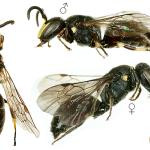This bee is a very close relative of the scarcer Hylaeus incongruus Förster (formerly misidentified in Britain as H. gibbus (Saunders)) and the females of the two species can be difficult to distinguish apart, although the extent of the yellow facial markings offers the best character for identification. In southern England both species are occasionally found flying together.
Widely distributed throughout Britain though rare and sporadic in Scotland. In Ireland it is perhaps the commonest of the four species of Hylaeus that occur there. There are no records from the Channel Islands. It is a locally common bee in the southern half of Britain.
The species has a Trans-Palaearctic distribution, occurring from Fennoscandia to Iberia, east to China, Mongolia and the far east of the Russian Federation (Magadan, Primor’ye, Sakhalin) (Koster, 1986; Ascher & Pickering, 2012).
The species is not regarded as scarce or threatened.
Mainly associated with open deciduous woodland but it also occurs in bushy places on chalk grassland, heaths, fens and on the coast.
Presumed to be univoltine in the British Isles, flying from late May to the end of September. However, in France it is reported to be bivoltine, with spring and autumn broods (Janvier, 1972). This may also occur in the British Isles but has not so far been confirmed.
Nests in a variety of burrows in dead stems and wood; a female has been seen burrowing in the ground. The nest has been described by Wiering (1954).
Buttercup, mallow, cabbage, mignonette, bramble, cinquefoil, rose, water-dropwort, hogweed, hedge-parsley, wild carrot, speedwell, sheep’s-bit, devil’s-bit scabious, creeping thistle and goldenrod.
The gasteruptiid wasp Gasteruption jaculator (Linnaeus) has been reared from a trap-nest containing a nest of this bee (C.R. Vardy, pers. comm.).
2018


